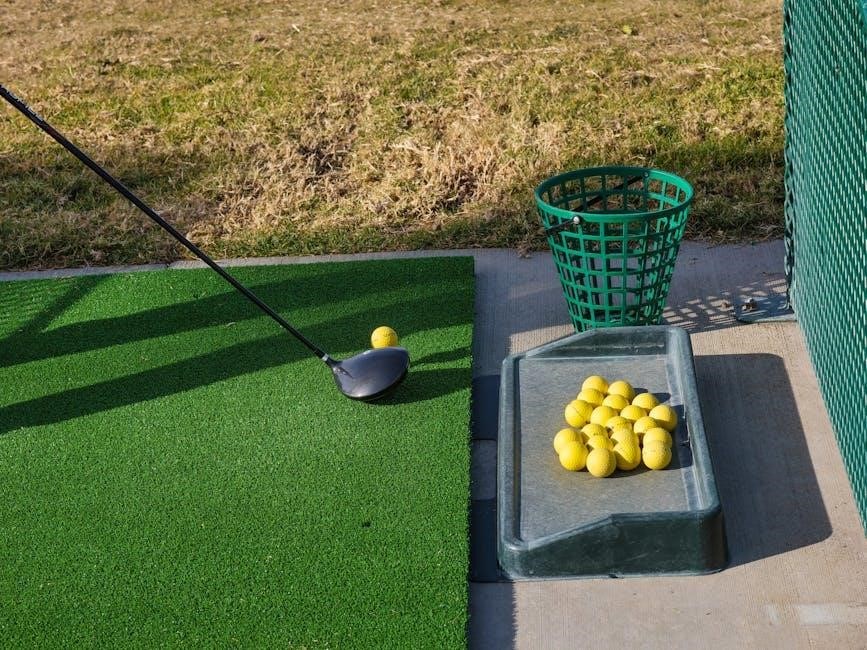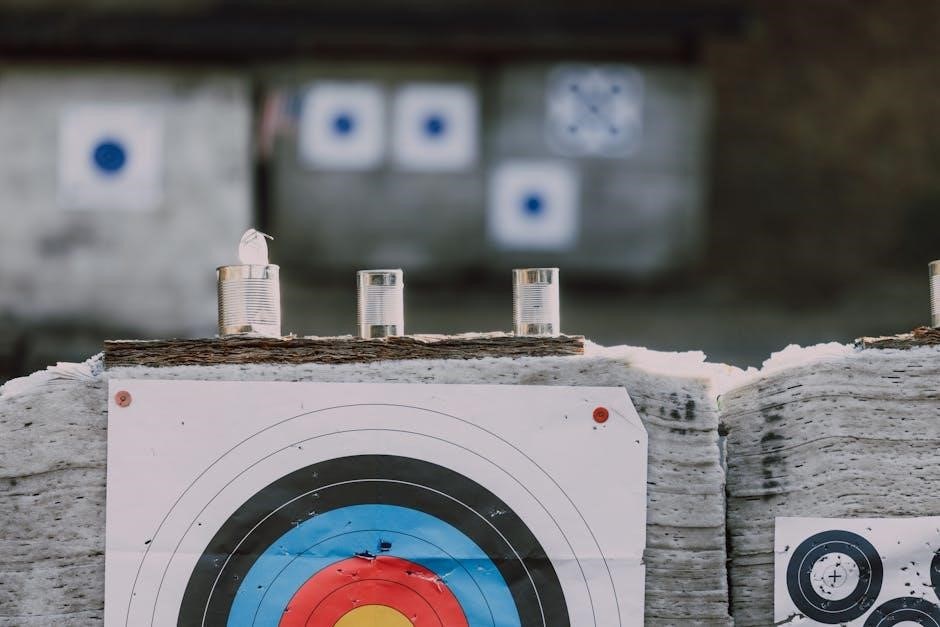A structured driving range practice plan PDF offers golfers a clear roadmap to improve their game. It helps players focus on specific areas, track progress, and maintain consistency.
Overview of the Importance of a Structured Practice Plan
A structured driving range practice plan PDF is essential for organizing your sessions efficiently. It helps set measurable goals, track progress, and ensure consistency in improvement. By focusing on specific areas like long and short games, you can identify weaknesses and prioritize drills. A well-planned approach enhances accountability, reduces practice time waste, and builds confidence. It also allows for mental preparation and adaptability, ensuring long-term progress and enjoyment of the game.
Benefits of Using a PDF Format for Golf Practice Plans
Using a PDF format for golf practice plans offers numerous advantages. It allows for easy access and sharing across devices, ensuring you can review your plan anytime, anywhere. PDFs are also editable, enabling you to log progress, note weaknesses, and adjust drills as needed. The format is universal, making it compatible with various platforms, and its professional layout enhances readability. This versatility makes PDFs an ideal choice for organizing and managing your golf improvement journey effectively.

Creating a Personalized Driving Range Practice Plan
A personalized driving range practice plan begins with self-assessment and goal-setting. Tailor your sessions to address strengths and weaknesses, focusing on specific skills like long game accuracy or short game precision.
Assessing Your Current Golf Game and Setting Goals
Evaluating your golf game involves identifying strengths and weaknesses. Start by analyzing your technique, consistency, and performance in key areas like driving, iron play, and putting. Set SMART goals (Specific, Measurable, Achievable, Relevant, Time-bound) to guide your practice. For example, aim to reduce your slice or improve putting accuracy. This self-assessment ensures your practice plan is tailored to your needs and helps track progress effectively. Regular reflection keeps your goals aligned with your improvement journey.
Understanding Key Areas to Focus On: Long Game, Short Game, and Putting
A well-rounded practice plan targets three main areas: the long game, short game, and putting. The long game focuses on driving and fairway shots, emphasizing distance and accuracy. The short game involves chipping and bunker shots, requiring precision and control. Putting is crucial for scoring, stressing green reading and consistent pacing. Balancing practice across these areas ensures comprehensive improvement and prepares you for all on-course challenges. Tailor your sessions to address weaknesses in each category for optimal results.

Warm-Up and Preparation Routine
A proper warm-up prevents injuries and improves performance. Start with light cardio and dynamic stretches, then move to slow swings to loosen muscles. Organize your space efficiently for an effective session.
Essential Stretches and Mobility Exercises for Golfers
A proper warm-up includes dynamic stretches like shoulder rotations, torso twists, and hip flexor stretches to enhance flexibility and prevent injury. Focus on slow, controlled movements to improve range of motion. Incorporate light cardio, such as jogging in place or jumping jacks, to increase blood flow. Mobility exercises, like arm circles and leg swings, prepare muscles for the repetitive motions of golf. Prioritize these routines to ensure a safe and effective practice session.

How to Properly Set Up Your Equipment and Space at the Range
Begin by organizing your clubs in a logical order, starting with the longest club like the driver. Position the ball on a consistent spot, aligning it with your target. Ensure your stance is balanced and feet shoulder-width apart. Keep a towel and water bottle nearby for convenience. Maintain a clean and distraction-free area to stay focused. Proper setup enhances efficiency and helps you maximize your practice session.

Drills for Specific Clubs and Shots
Target specific clubs and shots to enhance your skills. Identify weak areas and focus on drills that address them. Use video recording to analyze your swing and improve accuracy.
Enhance your iron play with drills that focus on consistent ball-striking and pinpoint accuracy. Use alignment aids to check your stance and swing path. Practice hitting shots with different ball positions to develop control. Video recording your swing can reveal flaws, while tempo drills ensure a smooth motion. Regularly incorporate iron-specific exercises to build muscle memory and confidence in your long game. Master your driver with drills designed to boost distance and accuracy. Focus on proper grip pressure and alignment to minimize slices. Practice tee height adjustments to optimize ball flight. Use weighted clubs for strength training and tempo drills for consistent swing speed. Incorporate video analysis to identify and correct flaws, ensuring a powerful and precise drive every time. Regular practice with these drills will elevate your game. Elevate your wedge game with focused drills for pitching and chipping. Practice varying swing lengths and angles to control distance and trajectory. Use alignment aids to ensure consistent ball positioning. Work on soft hands and precise contact to achieve better spin control. Incorporate ladder drills to improve accuracy and distance control. Regular practice with these techniques will help you master wedge play and lower your scores. Focus on refining your chipping, pitching, and bunker shots. Develop a consistent pre-shot routine and practice from various lies to build confidence and accuracy around the greens; Effective putting drills are crucial for improving green reading and pacing. Practice with drills like the “Lag Putt” to control speed and the “Circle Drill” to enhance accuracy. Use alignment aids to ensure consistent setup. Analyze the break and slope by studying the green’s topography. Record each putt’s outcome to identify patterns and areas for improvement. Regular practice builds muscle memory and confidence on the greens. Mastering chipping and bunker shots is essential for lowering your score. Practice chipping with different clubs to develop control and accuracy. For bunker shots, focus on stance and ball position to ensure consistent escape. Use drills like the “Sand Splash” to improve technique. Record your progress and identify areas needing refinement. Regular practice in these areas can significantly enhance your short game performance and confidence around the greens. Mental preparation is crucial for a productive practice session. Use positive visualization to build confidence and stay focused. Practice mindfulness to maintain concentration and improve performance. Positive visualization is a powerful tool to enhance your golf game. By mentally rehearsing successful shots, you can build confidence and develop a stronger mindset. This technique helps you stay focused and composed under pressure, allowing you to perform at your best. Regular visualization practice can lead to improved consistency and accuracy on the driving range. It’s a key component of a successful practice plan. Maintaining focus during practice is essential for improvement. Start with a clear plan and set specific goals for each session. Break your practice into focused intervals, such as dedicating time to specific drills. Use visualization techniques to stay engaged and mentally rehearse successful shots. Minimize distractions by creating a routine that keeps you centered. Celebrate small achievements to stay motivated and maintain a positive mindset throughout your practice. Consistency is key to progress. A proper cool-down involves stretching to prevent injury and promote recovery. Review your session, logging progress and identifying areas for improvement in your practice plan. After each practice, take time to reflect on your performance. Identify which drills improved your technique and which areas still need attention. Use your PDF plan to log specific observations, such as increased accuracy with irons or persistent issues with slicing. This review process helps refine your approach, ensuring each session builds on progress while addressing weaknesses effectively. Consistent evaluation is key to continuous improvement. Ending your practice with a proper cool-down is essential for preventing injuries and aiding recovery. Gentle stretches for your shoulders, back, and hamstrings can reduce muscle tension. Incorporate light swings and slow, controlled movements to gradually lower your heart rate. A structured cool-down routine, as outlined in your PDF plan, ensures your body recovers effectively, maintaining flexibility and readiness for future sessions. Consistency in this step is vital for long-term performance. Regularly tracking your progress in the PDF plan helps identify strengths and weaknesses. Use the log to monitor improvements and adjust your practice schedule as needed. A driving range practice plan PDF allows you to systematically track your progress. By logging scores, distances, and accuracy, you can identify areas needing improvement. Regularly reviewing the data helps pinpoint weaknesses and measure growth over time. This structured approach ensures your practice remains focused and effective, enabling you to make data-driven adjustments for consistent enhancement. Regularly evaluating your practice results is crucial for growth. If you consistently achieve your goals, consider increasing difficulty or focusing on new skills. Conversely, if progress stalls, reassess your approach and adjust drills or time allocation. A flexible driving range practice plan PDF adapts to your evolving needs, ensuring continuous improvement and keeping your training dynamic and effective. Stay proactive and open to changes that enhance your performance. Consistency and dedication are key to improving your golf game. Celebrate small achievements, stay committed, and you’ll see steady progress over time. Keep practicing! Stay consistent with your driving range practice plan PDF to see steady progress. Set achievable goals, track improvements, and celebrate small victories to stay motivated. Focus on addressing weaknesses while refining strengths. Regular review and adjustment of your plan ensure it remains effective. Keep a positive mindset and embrace the process of continuous improvement in your golf game. Celebrate each small victory to maintain motivation in your driving range practice plan PDF. Recognizing progress, no matter how minor, boosts confidence and encourages consistent effort. Set realistic milestones and reward yourself for achieving them. Embrace the journey, stay patient, and remind yourself why you started. A positive mindset and persistent practice are key to long-term success in your golf improvement journey.Iron Play: Drills to Improve Consistency and Accuracy

Driver Drills: Maximizing Distance and Reducing Slices
Wedge Play: Mastering Pitching and Chipping Techniques
Short Game Practice Strategies
Putting Drills: Enhancing Green Reading and Pacing
Chipping and Bunker Shots: Tips for Better Scoring

Mental Preparation and Focus

Building Confidence Through Positive Visualization
Staying Focused: How to Maintain Concentration During Practice
Cool-Down and Review
Reviewing Your Practice Session: What Worked and What Didn’t
Cool-Down Exercises to Prevent Injury and Promote Recovery
Tracking Progress and Adjusting the Plan
Using a PDF Plan to Log Improvements and Identify Weaknesses
When to Adjust Your Practice Plan Based on Results
Final Tips for Consistent Improvement
Stay Motivated: Celebrate Small Wins and Keep Practicing
